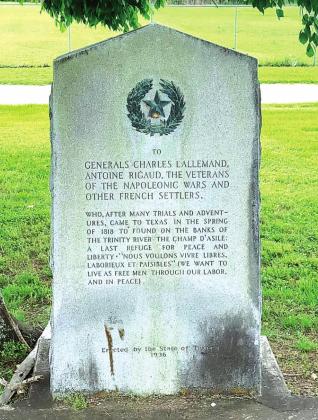LALLEMAND, RIGUAD AND OTHER FRENCH SETTLERS
In early 1818, French veterans of the Napoleonic Wars led by Generals Charles Lallemand and Antoine Rigaud founded a colony of refugees on the Trinity River somewhere between Moss Bluff and Atascosito. The colony was named Champ d’Asile, translated “Asylum Field.” Today, after decades of archaeological “digs,” the exact location is still in question and much debated. The French colonists were assisted by pirate Jean Lafitte and his men who were based on Galveston Island. Approximately 150 settlers, consisting of officers, a few women and children, orderlies, servants, and laborers of different nationalities were portrayed as wanting to establish a peaceful, agricultural settlement on the banks of the Trinity. However, it is questionable what the French officers really had in mind since this area of pre-Republic Texas was a no-man’s land claimed by several countries. There is no evidence the colonists were serious about agriculture, but they did build their fort and manufacture munitions while almost starving. The new colony was strategically located out of the reach of Mexican officials in San Antonio or Saltillo and out of control of the United States officials because it lay west of the Neutral Strip, a zone the United States had pledged in 1806 not to traverse. Many powerful officials despite the “hands off” policy in 1818 were still interested in Texas and who would capture the prize. There were many players waiting on the sidelines or perhaps Texas would be left in the hands of the corsairs on Galveston Island and their slave-smuggling activities.
The colonists faced difficulties from the beginning when one of their barges sank, settlers drowned, and supplies were lost. Hunger and sickness from eating what colonists thought to be lettuce but was in fact, a poisonous weed almost annihilated the colonists until the Alabama Coushatta Indians provided an antidote which saved their lives. A site was selected, and the building of forts and residences began. Lumber was plentiful, along with game, fish and wildflowers and the colonists’ spirits were uplifted. But as the season changed, so did their spirits. With the unbearable heat and mosquitoes during summer along the Trinity River, came thefts, brawls, duels, and assassinations. Desertions and beatings were common. The friendly Indians who had helped them settle began to steal their supplies and pillage their meager crops. Cannibalistic Karankawa Indians, who also inhabited the area, began to capture, slaughter, and eat men who left the compound on hunting expeditions. The different factions in the colony began to fight, including Lallemand and Riguad. Without progress, they were beginning to wonder why they were in Texas! They were without food and starving, without families and women, essentially without hope. In the middle of this strife, Lallemand learned in July that Mexican troops from San Antonio de Bexar were moving against the colony to force the French “intruders” out of the disputed territory. After much discussion, Lallemand wisely decided to disband the colony, less than 5 months after arriving. Approximately 200 colonists hastily abandoned Champ d’Asile and returned to Galveston and the protection of Jean Laffite.
We may never know the true intentions of Generals Lallemand and Riguad or the exact location of this early settlement, a last refuge for peace and liberty “Nous voulons vivre libres, laborieux et paisables” (We want to live as free men through our labor, and in peace). It may elusively remain a mystery lost in time only portrayed in French books and illustrations of the era with the remainder buried in the bottom of the mighty Trinity.

